BSc 1st Year Botany Anthoceros Sample Model Practice Question Answer Papers
BSc 1st Year Botany Anthoceros Sample Model Practice Question Answer Papers: BSc is a three-year program in most universities. Some of the universities also offer BSc Honours. After getting enrolled for BSc, there are certain things you require the most to get better grades/marks in BSc. Out of those, there are BSc Study Material, BSc Sample Model Practice Mock Question Answer Papers along with BSc Previous Year Papers. At gurujistudy.com you can easily get all these study materials and notes for free. Here in this post, we are happy to provide you with BSc 1st Year Botany Anthoceros Sample Model Practice Question Answer Papers.
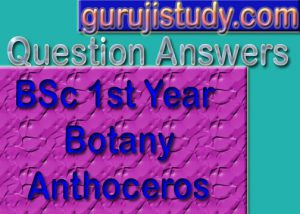
BSc 1st Year Botany Anthoceros Sample Model Practice Question Answer Papers
Q. 1. Describe in brief the life cycle of Anthoceros.
Ans.1. Anthoceros including about 200 species is cosmopolitan in distribution occurring in both temperate and tropical regions. About 25 species are found in India. It usually grows in damp and shady places. Main Indian species of Anthoceros are:
(1) Anthoceros himalayensis.
(2) Anthoceros chambensis.
(3) Anthoceros erectus.
These, three species of Anthoceros viz., A. himalayensis, A. erectus and A. chambensis have been described by Kashyap (1915) from Western Himalayas. At an altitude of 5000-8000 ft., these plants are found in Mussoorie, Kulu, Manali, Kumaon and Chamba valley and in the plains in South India. Anthoceros himalayensis and A. erectus have been reported from Simla, Nainital and Dalhousie also (Mehra and Handoo, 1953).
Anthoceros weistii has been reported from Rangoon (Khanna, 1932); 4. parkinsonii from Burma and A koshii from Travancore (Khanna, 1933). Two species of Anthoceros, A. dixitii and A. sahyadrensis have been found growing in Poona and the neighbouring hills (Sane, 1942). Anthoceros crispulus has been described from Lucknow by Pande and Bhardwaj (1949). Anthoceros assamicus has been described from Assam and A. shivanandani from Kerala (Kachroo, 1954, 1967).
The plants grow in very moist and shady places, by clay banks and ditches or in the crevices of rocks. A few species of Anthoceros occur on decaying woods (Cavers, 1911).
Structure of Thallus
The adult plants of Anthoceros present the gametophytic phase of life history. The gametophyte of Anthoceros is a dorsiventral plate like thallus. It is somewhat lobed of a radially disected which may result in irregular dichotomous branching. The thallus remain attached to substratum by means of rhizoids which are only of one type i.e., smooth walled. The tuberculated rhizoids scales and midrib are absent.
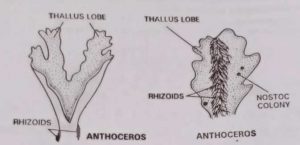
The dorsal surface of the thallus may be smooth (A. leavis) or rough with ridges (A. fusiformis) or velvety with many flat, leaflike, lobed lamellae (A. crisulus). The ventral surface of the thallus bears numerous smooth-walled rhizoids, the tuberculate rhizoids, the mucilage hairs and the scales are absent. Some species of Anthoceros (as A. punctatus var. cavernosus and A. erectus are annuals while others (A. leavis, A. fusiformis, A. himalayensis) are perennial.
Internal Structure of Thallus
The thallus of Anthoceros when seen in transverse section does not show any sort of differentiation of tissues. There is an outermost layer of epidermis and the inner parenchymatous tissue. The cells have a single large chloroplast with a conspicuous pyrenoid. The ventral portion of the thallus has certain intercellular cavities filled with mucilage. These cavities open by narrow slits. These cavities have endophytic colonies of blue green algae-Nostoc. Due to the presence of these algal colonies, the colour of the thallus becomes dark green. Whether the presence of Nostoc is useful for Anthoceros is not definitely known.
Reproduction
It may take place either vegetatively or by sexual means.
Vegetative reproduction
It may take place by the following method:
(i) By Death and Decay: By death and decay of the older portions of thallus, the young one are separated apart which lead an independent life and grow into adult plant.

(ii) By gemmae formation: In some species the gemmae formation takes place which on separation forms the new thallus.
(iii) By tubers formation: In some species e.g., A. tuberosus, A. thalli, A. himalayensis, A laevis, etc. tubers arise on the thallus during unfavourable conditions. They get detached from the thallus and give rise to new plant.
(iv) By persistent Species: In few species e.g., A. fusiformis the apices of gametophyte are capable of resisting under unfavourable conditions.
Sexual reproduction: The sexual reproduction is of highly advanced oogamous type, brought about by means of definite male (antheridium) and female (archegonium) reproductive organs. Usually the Anthoceros is homothallic or monoecious but in few species it may be heterothallic or dioecious. The antheridia and archegonia are borne on the same plant, and usually antheridia appear first. Both kinds of sex organs are embedded on the dorsal surface of thallus and develop endogenously.
Male Reproductive Organs
The male reproductive organs are antheridium, it develops from any superficial cell of the dorsal surface of gametophyte this cell increases in size and divide by periclinal division into inner antheridial initial and outer sterile roof cell. The antheridial initial divides into a primary antheridia cell and a primary stalk cell.
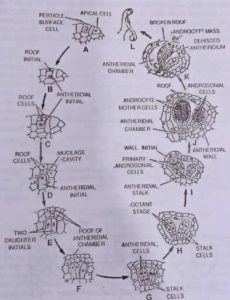
The primary stalk cell gives rise to stalk and primary antheridial cells divides by two vertical walls at night angles to each other and then by two transverse walls thus forming three tiers with four cells in each tier Side by side the sterile roof initial cell increases in side around the antheridium to form antheridial chamber. The lowest tier gives rise to the stalk, while the two upper tiers divide by periclinal divisions into outer primary jacket cells and inner primary androgonial cells.
The primary jacket cells from the sterile layer, while the primary androgonial cells divide repeatedly into androgonial cells. The androgonial cells become androcytes and the androcytes metamorphose into bicilliated antherozoids.
In certain species of Anthoceros, the antheridial initial may divide by vertical divisions and each daughter cell develops into and antheridium. Thus, a single antheridial chamber may have two or more antheridia in it.
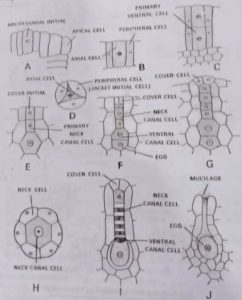
The mature antheridium usually orange-yellow in colour. It has a spherical body with a long stalk. The roof of the antheridia burst irregularly thus exposing the ripe antheridia. Thus, antheridia absorb water and swell and ultimately break, thus exposing the antherozoids.
Female Reproductive Organs
The female reproductive organs in Anthoceros are archegonia; the archegonia are also embedded in the dorsal surface of thallus. Any cell for dorsal surface of thallus behaves as archegonial initial cell and functions directly as primary archegonial cell. In the primary archegonial cell as usual three vertical wall appears cutting off the three jacket initials or wall cells surrounding the central primary axial cell.
The primary axial cell divides transversely into a central cell and over initial. The central cell divides by a transverse division into a primary, venter cell and primary neck canal cell. The cover initial divide by vertical wall and form four cover cells. The primary neck canal cell divides and redivides and gives rise to four to six neck canal cells. The primary venter cell divides transversely to form venter canal cells and egg. The mature archegonium is a flask shaped structure.
Fertilization
The water medium is essential for fertilization. When the archegonium is fully mature its neck canal cells and venter canal cell disorganise forming a mucilage substance which absorbs water, thus creating a pressure that bring about the opening of the cover cell. Motile antherozoids enter through this opening and ultimately one sperm fuses with egg forming a diploid oospore or zygote.
SHOROPHYTE
The zygote or oospore is the first cell of the sporophyte.
Oospore or zygote first increases in size and fills the venter and then begins to divide. The zygote first of all divides by a vertical division and then again divides by a vertical division at right angles to the plane of first division.
In this way eight celled embryo is forming having two tiers of four cells each. The upper tier of four cells forms the capsular region while the lower tier forms the bulbous foot. (BSc 1st Year Botany Anthoceros Sample Model Practice Question Answer Papers)
The upper tier of four cells divides by one or two forming an outer amphethecium and inner endothecium. In Anthoceros the endothecium gives rise to sterile columella. (BSc 1st Year Botany Anthoceros Sample Model Practice Question Answer Papers)
Young sporophytes of embryo have columella having four vertical rows of cell, while old ones have six vertical rows of cell. The amphethecium divides by one more periclinal wall forming outer amphethecium and inner amphethecium.
The outer amphethecium forms jacket layer and inner amphethecium gives rise to sporogenous tissue or archesporium. The outer jacket layer divide further by pericilinal division and becomes 4 to 6 cell in thickness and the outermost layer known as epidermis having stomata in some case.

BSc Botany Anthoceros Question Answers
In young sporangium the archesporium over arches the columella. The archesporium is mostly one cell in thickness but in some species it may be two or three layered. The sporogenous tissue soon get differentiated into two types of cell i.e., sporocytes or spores mother cell and sterile pseudoelaters,
Each spore mother cell divides twice, one by reduction division (Meiosis) and other by simple division, and forms four spores each with haploid number of chromosomes. The spores in the upper part of the sporogonium mature first. The intermediate zone of sporogonium elongates constantly and thus adds to the capsular region from below. In this way the spore formation takes a pretty long time. (BSc 1st Year Botany Anthoceros Sample Model Practice Question Answer Papers)

The foot is formed from the lower tiers of four cells. The lower tier divides and redivides and forms a bulbous foot. Some cell of the foot near the capsule becomes meristematic and forms a short seta.
The mature sporophyte or sporogonium is an erect cylindrical structure consists of expanded or bulbous foot and smooth slender, erect, cylindrical capsule which may project 2 to 3 centimetre-but sometimes upto 15 cm, above the surface of gametophytic thallus. The foot absorbs food from gametophyte. The capsule in made up of several tissues.
It has a central column of sterile cells, the columella, surrounded by the sporogenous tissue which consists of spores and elaters. The wall of capsule is and elaters. The wall of capsule is 4 to 5 layered, with an outer layer of epidermis which have stomata.
Dehiscence of Capsule and Liberation of Spore
The capsule when dried is brown or black in colour and by the loss of water and hygroscopic movements of pseudoelaters the capsule get twisted and the wall of capsule ruptures and the spore get liberated free.
GAMETOPHYTE
The spore is the first cell of the gametophyte. Each spore is uniculeate and possesses outer exine and intine walls. It has a single colorless plastid, oil globules, and foot material. After liberation, the spores undergo a period of rest of a few weeks or months.
After the period of rest, the exine ruptures and the intine comes outside in the form of a tube called a germinal tube or protonema. It cuts off segments and forms the new thallus. (BSc 1st Year Botany Anthoceros Sample Model Practice Question Answer Papers)
The life cycle of Anthoceros
The life cycle of Anthoceros has been presented diagrammatically and graphically in Figure glance at the two figures reveals that:
(i) The gametophytic generation begins with the production of haploid spores by reduction division.
(ii) The spores germinate into thallus, the main component of the gametophytic generation. The thallus as well as all the structures produced on its vegetative reproductive bodies (persistent apices, tubers, gemmae), and sexual reproductive organs (antheridia, archegonia) all have ‘x’ no of chromosomes.
(iii) The gametophyte has the capacity to grow, propagate and multiply indefinitely and is the dominant phase.
(iv) With the fertilization of the egg and production of zygote (which is diploid), the sporophyte generation starts. It is represented by sporogonium.
(v) Sporogonium, though endowed with capacity to grow by the action of intermediate meristematic, does not have the same capacity, to propagate, multiply as we see in the case of gametophytic generation. The entire tissue of sporogonium (cells of foot, meristematic zone, wall of capsule, columella, archesporium and its products i.e., spore mother cells, pseudoelaters) are all diploid. (BSc 1st Year Botany Anthoceros Sample Model Practice Question Answer Papers)
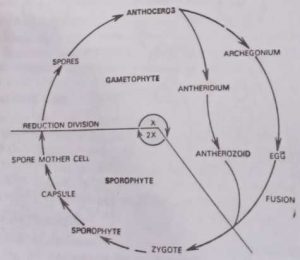
(vi) The sporogonium, however, remains attached to the thallus and derives its nutrition from the thallus by the foot. An envelope or collar of the gametophytic tissue protects the lower part of the sporogonium i.e., haploid tissue (the involucre).
(vii) The spore’s mother cell is the last generation of sporophyte and undergoes meiosis to form 4 meiospores.
(viii) The two generations (or phases) the sporophyte and the gametophyte-occur regularly one after the other. The life cycle thus exhibits regular alternation of generations.
BSc 1st Year Botany Anthoceros Sample Model Practice Question Answer Papers
BSc 1st Year Botany Anthoceros Sample Model Practice Question Answer Papers
BSc 1st Year Sample Model Practice Mock Test Question Answer Papers